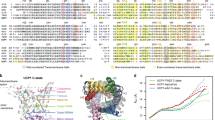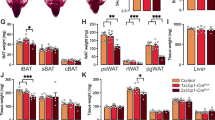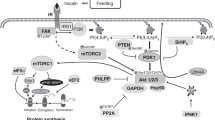Abstract
Prematurity is associated with delayed postnatal activation of mitochondrial oxidative phosphorylation and impaired switch from glycolytic to oxidative metabolism. Fatty acids (FA), which represent a major energy substrate in mature muscle cells, are engaged in the postnatal activation of genes of energy metabolism and lipid oxidation. To understand the mechanism activating mitochondria in human newborns, expression of the genes for mitochondrial uncoupling proteins (UCP) was characterized in autopsy samples of skeletal (n = 28) and cardiac (n = 13) muscles of preterm neonates, who mostly died during the first postnatal month, and two aborted fetuses. Transcripts levels for UCP2, UCP3, and also for genes engaged in the transport of FA between cytoplasm and mitochondria were measured using real-time reverse transcriptase PCR. In accordance with studies in mice, our results document postnatal induction of UCP3 gene expression in skeletal muscle, involvement of nutritional FA in the induction, and a role of UCP3 in mitochondrial FA oxidation. They suggest impaired postnatal activation of UCP3 gene in neonates delivered before approximately 26 wk of gestation. Mean levels of the UCP3 transcript in skeletal muscle were by two orders of magnitude higher than in the heart. In contrast to UCP3, the UCP2 gene was active in fetuses, and its expression was not affected by nutrition. Our results support a role of UCP3 in postnatal activation of lipid oxidation in skeletal muscle and suggest the involvement of UCP3 in the delayed activation of mitochondrial energy conversion in very immature preterm neonates.
Similar content being viewed by others
Log in or create a free account to read this content
Gain free access to this article, as well as selected content from this journal and more on nature.com
or
Abbreviations
- CPT-1:
-
carnitine palmitoyltransferase I isoform β
- EF-1α:
-
elongation factor 1α
- FA:
-
fatty acids
- MTE-1:
-
mitochondrial thioesterase 1
- PPAR:
-
peroxisome proliferator-activated receptor
- UCP:
-
uncoupling protein
References
Izquierdo JM, Luis AM, Cuezva JM 1990 Postnatal mitochondrial differentiation in rat liver. J Biol Chem 265: 9090–9097
Schonfeld P, Schild L, Bohnensack R 1996 Expression of the ADP/ATP carrier and expansion of the mitochondrial (ATP + ADP) pool contribute to postnatal maturation of the rat heart. Eur J Biochem 241: 895–900
Schägger H, Noack H, Halangk W, Brandt U, von Jagow G 1995 Cytochrome-c oxidase in developing rat heart. Enzymic properties and amino-terminal sequences suggest identity of the fetal heart and the adult liver isoform. Eur J Biochem 230: 235–241
Valcarce C, Izquierdo JM, Chamorro M, Cuezva JM 1994 Mammalian adaptation to extrauterine environment: mitochondrial functional impairment caused by prematurity. Biochem J 303: 855–862
Sperl W, Sengers RC, Trijbels JM, Ruitenbeek W, Doesburg WH, Smeitink JA, Kollee LA, Boon JM 1992 Enzyme activities of the mitochondrial energy generating system in skeletal muscle tissue of preterm and full-term neonates. Ann Clin Biochem 29: 638–645
Ferré P, Decaux JF, Issad T, Girard J 1986 Changes in energy metabolism during the suckling and weaning period in the newborn. Reprod Nutr Dev 26: 619–631
Duplus E, Forest C 2002 Is there a single mechanism for fatty acid regulation of gene transcription?. Biochem Pharmacol 64: 893–901
Ricquier D, Bouillaud F 2000 The uncoupling protein homologues: UCP1, UCP2, UCP3, StUCP and AtUCP. Biochem J 345: 161–179
Enerbäck S, Jacobsson A, Simpson EM, Guerra C, Yamashita H, Harper ME, Kozak LP 1997 Mice lacking mitochondrial uncoupling protein are cold-sensitive but not obese. Nature 387: 90–94
Nibbelink M, Moulin K, Arnaud E, Duval C, Pénicaud L, Casteilla L 2001 Brown fat UCP1 is specifically expressed in uterine longitudinal smooth muscle cells. J Biol Chem 276: 47291–47295
Hodný Z, Kolářová P, Rossmeisl M, Horáková M, Nibbelink M, Pénicaud L, Casteilla L, Kopecký J 1998 High expression of uncoupling protein 2 in foetal liver. FEBS Lett 425: 185–190
Brun S, Carmona MC, Mampel T, Viñas O, Giralt M, Iglesias R, Villarroya F 1999 Activators of peroxisome proliferator-activated receptor-α induce the expression of the uncoupling protein-3 gene in skeletal muscle. Diabetes 48: 1217–1222
Brun S, Carmona MC, Mampel T, Viñas O, Giralt M, Iglesias R, Villarroya F 1999 Uncoupling protein-3 gene expression in skeletal muscle during development is regulated by nutritional factors that alter circulating non-esterified fatty acids. FEBS Lett 453: 205–209
Teshima Y, Saikawa T, Yonemochi H, Hidaka S, Yoshimatsu H, Sakata T 1999 Alteration of heart uncoupling protein-2 mRNA regulated by sympathetic nerve and triiodothyronine during postnatal period in rats. Biochim Biophys Acta 1448: 409–415
van der Lee KAJM, Willemsen PHM, van der Vusse GJ, van Bilsen M 2000 Effects of fatty acids on uncoupling protein-2 expression in the rat heart. FASEB J 14: 495–502
Langdown ML, Smith ND, Sugden MC, Holness MJ 2001 Excessive glucocorticoid exposure during late intrauterine development modulates the expression of cardiac uncoupling proteins in adult hypertensive male offspring. Pflugers Arch 442: 248–255
Yu XX, Mao W, Zhong A, Schow P, Brush J, Sherwood SW, Adams SH, Pan G 2000 Characterization of novel UCP5/BMCP1 isoforms and differential regulation of UCP4 and UCP5 expression through dietary or temperature manipulation. FASEB J 14: 1611–1618
Pecqueur C, Alves-Guerra MC, Gelly C, Lévi-Meyrueis C, Couplan E, Collins S, Ricquier D, Bouillaud F, Miroux B 2001 Uncoupling Protein 2 in vivo distribution, induction upon oxidative stress and evidence for translational regulation. J Biol Chem 276: 8705–8712
Arsenijevic D, Onuma H, Pecqueur C, Raimbault S, Manning BS, Miroux B, Couplan E, Alves-Guerra MC, Goubern M, Surwit R, Bouillaud F, Richard D, Collins S, Ricquier D 2000 Disruption of the uncoupling protein-2 gene in mice reveals a role in immunity and reactive oxygen species production. Nat Genet 26: 435–439
Nègre-Salvayre A, Hirtz C, Carrera G, Cazenave R, Troly M, Salvayre R, Pénicaud L, Casteilla L 1997 A role for uncoupling protein-2 as a regulator of mitochondrial hydrogen peroxide generation. FASEB J 11: 809–816
Vidal-Puig A, Solanes G, Grujic D, Flier JS, Lowell BB 1997 UCP3: an uncoupling homologue expressed preferentially and abundantly in skeletal muscle and brown adipose tissue. Biochem Biophys Res Commun 235: 79–82
Matsuda J, Hosoda K, Itoh H, Son C, Doi K, Tanaka T, Fukunage Y, Inoue G, Nishimura H, Yoshimasa Y, Yamori Y, Nakao K 1997 Cloning of rat uncoupling protein-3 and uncoupling protein-2 cDNAs: their gene expression in rats fed high-fat diet. FEBS Lett 418: 200–204
Esterbauer H, Oberkofler H, Krempler F, Strosberg AD, Patsch W 2000 The uncoupling protein-3 gene is transcribed from tissue-specific promoters in humans but not in rodents. J Biol Chem 275: 36394–36399
Gong DW, He Y, Karas M, Reitman M 1997 Uncoupling protein-3 is a mediator of thermogenesis regulated by thyroid hormone, beta3-adrenergic agonists, and leptin. J Biol Chem 272: 24129–24132
Boss O, Samec S, Paoloni-Giacobino A, Rossier C, Dulloo A, Seydoux J, Muzzin P, Giacobino JP 1997 Uncoupling protein-3: a new member of the mitochondrial carrier family with tissue-specific expression. FEBS Lett 408: 39–42
Weigle DS, Selfridge LE, Schwartz MW, Seeleym RJ, Cummings DE, Havel PJ, Kuijper JL, BeltrandelRio H 1998 Elevated free fatty acids induce uncoupling protein 3 expression in muscle: a potential explanation for the effect of fasting. Diabetes 47: 298–302
Samec S, Seydoux J, Dulloo AG 1998 Role of UCP homologues in skeletal muscles and brown adipose tissue: mediators of thermogenesis or regulators of lipids as fuel substrates?. FASEB J 12: 715–724
García-Martínez C, Sibille B, Solanes G, Darimont C, Macé K, Villarroya F, Gómez-Foix AM 2001 Overexpression of UCP3 in cultured human muscle lowers mitochondrial membrane potential, raises ATP/ADP ratio, and favors fatty acid versus glucose oxidation. FASEB J 15: 2033–2035
Himms-Hagen J, Harper ME 2001 Physiological role of UCP3 may be export of fatty acids from mitochondria when fatty acid oxidation predominates: a hypothesis. Exp Biol Med Maywood 226: 78–84
Cadenas S, Buckingham JA, Samec S, Seydoux J, Din N, Dulloo AG, Brand MD 1999 UCP2 and UCP3 rise in starved rat skeletal muscle but mitochondrial proton conductance is unchanged. FEBS Lett 462: 257–260
Clapham JC, Coulthard VH, Moore GB 2001 Concordant mRNA expression of UCP-3, but not UCP-2, with mitochondrial thioesterase-1 in brown adipose tissue and skeletal muscle in db/db diabetic mice. Biochem Biophys Res Commun 287: 1058–1062
Brown NF, Weis BC, Husti JE, Foster DW, McGarry JD 1995 Mitochondrial carnitine palmitoyltransferase I isoform switching in the developing rat heart. J Biol Chem 270: 8952–8957
Warrington JA, Nair A, Mahadevappa M, Tsyganskaya M 2000 Comparison of human adult and fetal expression and identification of 535 housekeeping/maintenance genes. Physiol Genomics 2: 143–147
Houšték J, Vízek K, Pavelka S, Kopecký J, Krejčová E, Heřmanská J, Cermáková S 1993 Type II iodothyronine 5′-deiodinase and uncoupling protein in brown adipose tissue of human newborns. J Clin Endocrinol Metab 77: 382–387
Pavelka S, Kopecký P, Bendlová B, Štolba P, Vítková I, Vobruba V, Plavka R, Houštěk J, Kopecký J 1997 Tissue metabolism and plasma levels of thyroid hormones in critically ill very premature infants. Pediatr Res 42: 812–818
Brauner P, Nibbelink M, Flachs P, Vítková I, Kopecky P, Mertelíková I, Janderová L, Pénicaud L, Casteilla L, Plavka R, Kopecky J 2001 Fast decline of hematopoiesis and uncoupling protein 2 content in human liver after birth: location of the protein in Kupffer cells. Pediatr Res 49: 440–447
Rings EH, Minich DM, Vonk RJ, Stellaard F, Fetter WP, Verkade HJ 2002 Functional development of fat absorption in term and preterm neonates strongly correlates with ability to absorb long-chain fatty acids from intestinal lumen. Pediatr Res 51: 57–63
Genzel-Boroviczeny O, Hrboticky N 1996 Plasma values of polyunsaturated fatty acids in extremely low birth weight (ELBW) infants fed breast milk or formula very early in life. Eur J Med Res 1: 495–498
Larque E, Demmelmair H, Koletzko B 2002 Perinatal supply and metabolism of long-chain polyunsaturated fatty acids: importance for the early development of the nervous system. Ann N Y Acad Sci 967: 299–310
Muoio DM, MacLean PS, Lang DB, Li S, Houmard JA, Way JM, Winegar DA, Corton JC, Dohm GL, Kraus WE 2002 Fatty acid homeostasis and induction of lipid regulatory genes in skeletal muscles of peroxisome proliferator-activated receptor (PPAR) alpha knock-out mice. Evidence for compensatory regulation by PPAR delta. J Biol Chem 277: 26089–26097
Pedersen SB, Lund S, Buhl ES, Richelsen B 2001 Insulin and contraction directly stimulate UCP2 and UCP3 mRNA expression in rat skeletal muscle in vitro. Biochem Biophys Res Commun 283: 19–25
Zhou M, Lin BZ, Coughlin S, Vallega G, Pilch PF 2000 UCP-3 expression in skeletal muscle Effects of exercise, hypoxia, and AMP-activated protein kinase. Am J Physiol Endocrinol Metab 279: E622–E629
Minokoshi Y, Kim YB, Peroni OD, Fryer LG, Muller C, Carling D, Kahn BB 2002 Leptin stimulates fatty-acid oxidation by activating AMP-activated protein kinase. Nature 415: 339–343
Solanes G, Pedraza N, Iglesias R, Giralt M, Villarroya F 2000 The human uncoupling protein-3 gene promoter requires MyoD and is induced by retinoic acid in muscle cells. FASEB J 14: 2141–2143
Hidaka S, Kakuma T, Yoshimatsu H, Sakino H, Fukuchi S, Sakata T 1999 Streptozotocin treatment upregulates uncoupling protein 3 expression in the rat heart. Diabetes 48: 430–435
Kratky D, Strauss JG, Zechner R 2001 Tissue-specific activity of lipoprotein lipase in skeletal muscle regulates the expression of uncoupling protein 3 in transgenic mouse models. Biochem J 355: 647–652
Vidal-Puig AJ, Grujic D, Zhang CY, Hagen T, Boss O, Ido Y, Szczepanik A, Wade J, Mootha V, Cortright R, Muoio DM, Lowell BB 2000 Energy metabolism in uncoupling protein 3 gene knockout mice. J Biol Chem 275: 16258–16266
Buonocore G, Perrone S, Longini M, Vezzosi P, Marzocchi B, Paffetti P, Bracci R 2002 Oxidative stress in preterm neonates at birth and on the seventh day of life. Pediatr Res 52: 46–49
Frayn KN, Summers LKM 1998 Substrate fluxes in skeletal muscle and white adipose tissue and their importance in the development of obesity. In: Kopelman PG, Stock MJ (eds) Clinical Obesity. Blackwell Science Ltd, Oxford, pp 129–157.
Huppertz C, Fischer BM, Kim YB, Kotani K, Vidal-Puig A, Slieker LJ, Sloop KW, Lowell BB, Kahn BB 2001 Uncoupling protein 3 (UCP3) stimulates glucose uptake in muscle cells through a phosphoinositide 3-kinase-dependent mechanism. J Biol Chem 276: 12520–12529
Clapham JC, Arch JR, Chapman H, Haynes A, Lister C, Moore GB, Piercy V, Carter SA, Lehner I, Smith SA, Beeley LJ, Godden RJ, Herrity N, Skehel M, Changani KK, Hockings PD, Reid DG, Squires SM, Hatcher J, Trail B, Latcham J, Rastan S, Harper AJ, Cadenas S, Buckingham JA, Brand MD, Abuin A 2000 Mice overexpressing human uncoupling protein-3 in skeletal muscle are hyperphagic and lean. Nature 406: 415–418
Gimeno RE, Dembski M, Weng X, Deng N, Shyjan AW, Gimeno CJ, Iris F, Ellis SJ, Woolf EA, Tartaglia LA 1997 Cloning and characterization of an uncoupling protein homolog. Diabetes 46: 900–906
Fleury C, Neverova M, Collins S, Raimbault S, Champigny O, Lévi-Meyrueis C, Bouillaud F, Seldin MF, Surwit RS, Ricquier D, Warden CH 1997 Uncoupling protein-2: A novel gene linked to obesity and hyperinsulinemia. Nat Genet 15: 269–272
Hesselink MK, Keizer HA, Borghouts LB, Schaart G, Kornips CF, Slieker LJ, Sloop KW, Saris WH, Schrauwen P 2001 Protein expression of UCP3 differs between human type 1, type 2a, and type 2b fibers. FASEB J 15: 1071–1073
Acknowledgements
The authors thank Dr. Martin Rossmeisl and Prof. Arnošt Kotyk for critical reading of the manuscript.
Author information
Authors and Affiliations
Additional information
Supported by the Internal Grant Agency of the Ministry of Health of the Czech Republic (grant NE/6430-5) and the March of Dimes Birth Defects Foundation (grant #6-FY00-331).
Rights and permissions
About this article
Cite this article
Brauner, P., Kopecký, P., Flachs, P. et al. Induction of Uncoupling Protein 3 Gene Expression in Skeletal Muscle of Preterm Newborns. Pediatr Res 53, 691–697 (2003). https://doi.org/10.1203/01.PDR.0000054687.07095.0B
Received:
Accepted:
Issue date:
DOI: https://doi.org/10.1203/01.PDR.0000054687.07095.0B



